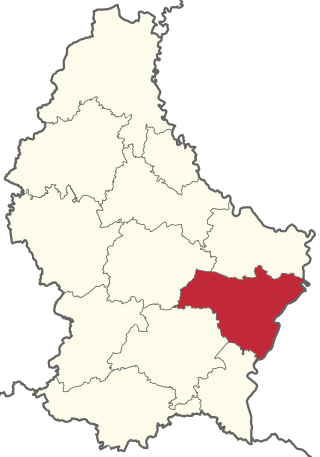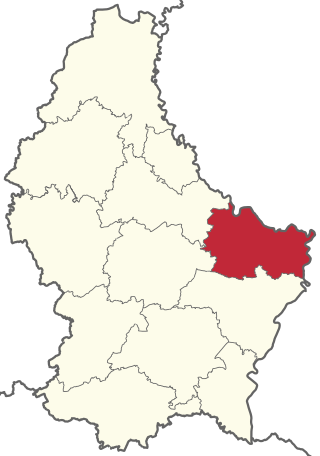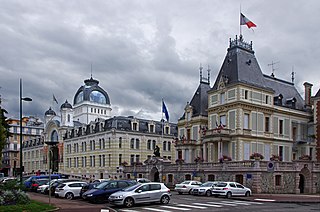 |
|---|
The Grand Duchy of Luxembourg is divided into cantons, which group the communes (= municipalities). A dozen of the communes have official city status, and one, Luxembourg City, is unofficially further divided into quarters.
Contents

 |
|---|
The Grand Duchy of Luxembourg is divided into cantons, which group the communes (= municipalities). A dozen of the communes have official city status, and one, Luxembourg City, is unofficially further divided into quarters.

Luxembourg was divided into three districts until their abolition in October 2015: [1]
There are a total of 12 cantons, which were previously a subdivision of the districts but are now the first-level subdivision of Luxembourg: [1] [2]
The communes (municipalities) are the lowest administrative division in Luxembourg. They were first created during the French Revolution. [1] As of 2020, there were 102 communes. [2]
12 communes have legal city status. Luxembourg City, the nation's capital, is the largest city in the country. [2]
Below the official administrative level of the commune, Luxembourg City has further unofficial administrative subdivisions, known as quarters. The twenty-four quarters [3] of Luxembourg City are a de facto subdivision without legal basis used to simplify public administration.[ citation needed ]
There are four electoral constituencies of Luxembourg: Centre, East, North, and South. [1]

Luxembourg, also known as Luxembourg City, is the capital city of Luxembourg and the country's most populous commune. Standing at the confluence of the Alzette and Pétrusse rivers in southern Luxembourg, the city lies at the heart of Western Europe, situated 213 km (132 mi) by road from Brussels and 209 km (130 mi) from Cologne. The city contains Luxembourg Castle, established by the Franks in the Early Middle Ages, around which a settlement developed.

The three districts of Luxembourg were the top-level administrative divisions of the Grand Duchy of Luxembourg. The districts were further subdivided into cantons, which still exist:

The District of Luxembourg was one of three districts of the Grand Duchy of Luxembourg. It contained four cantons, divided into 44 communes:

The District of Diekirch was one of three districts of the Grand Duchy of Luxembourg. Immediately prior to its abolition on 3 October 2015, it contained five cantons divided into 43 communes:

The District of Grevenmacher was one of three districts of Luxembourg. It contained three cantons divided into 25 communes:

Forêts was a department of the French First Republic, and later the First French Empire, in present-day Belgium, Luxembourg, and Germany. Its name, meaning 'forests', comes from the Ardennes forests. It was formed on 24 October 1795, after the Austrian Netherlands had been annexed by France on 1 October. Before annexation, the territory was part of the Duchy of Luxembourg and small parts of the Duchy of Bouillon. Its capital was Luxembourg City.
The 12 cantons of the Grand Duchy of Luxembourg are subdivisions at the first level of local administrative unit (LAU-1) in the European Union's Nomenclature of Territorial Units for Statistics for Eurostat purposes. They were subdivisions of the three districts of Luxembourg until 2015, when the district level of government was abolished. The cantons are in turn subdivided into 100 communes.

Grevenmacher is a canton in the east of Luxembourg. The canton's name derives from Grevenmacher, a commune with town status. Neither the canton, town, or commune of Grevenmacher should be confused with the former district of Grevenmacher, one of three administrative units in Luxembourg abolished in October 2015. It borders Germany.

Diekirch is a canton in the north of Luxembourg. Neither the canton, town, nor commune of Diekirch should be confused with the former district of Diekirch, one of three administrative units in Luxembourg abolished in October 2015. It borders Germany.

Diekirch is a commune with town status in north-eastern Luxembourg, in the canton of Diekirch and, until its abolition in 2015, the district of Diekirch. The town is situated on the banks of the Sauer river.

Echternach is a canton in the east of Luxembourg. It is largely coterminous with the Mullerthal region. It borders Germany.

Remich is a canton in the south-east of Luxembourg. It borders Germany & France.

An administrative centre is a seat of regional administration or local government, or a county town, or the place where the central administration of a commune, is located.

Grevenmacher is a commune with town status in eastern Luxembourg, near the border with Germany. It gives its name to the canton of Grevenmacher, and, until its abolition in 2015, the district of Grevenmacher. The town is situated on the left bank of the river Moselle, in a wine growing region.

Luxembourg's 100 communes conform to LAU Level 2 and are the country's lowest administrative divisions.

Erpeldange-sur-Sûre is a commune and small town in north-eastern Luxembourg. It lies along the river Sûre, between Ettelbruck and Diekirch. It is part of the canton of Diekirch.

Constituencies are used to elect representatives ('deputies') to Luxembourg's unicameral national legislature, the Chamber of Deputies.

The Quarters of Luxembourg City are the smallest administrative division for local government in Luxembourg City, the capital and largest city in the Grand Duchy of Luxembourg.